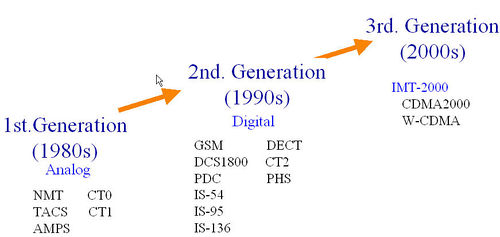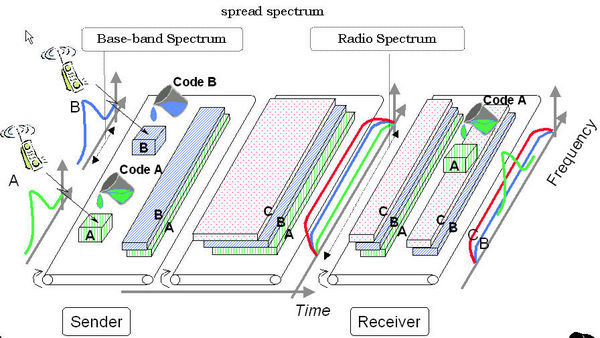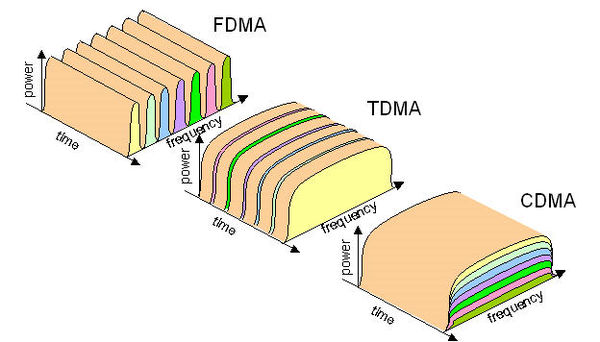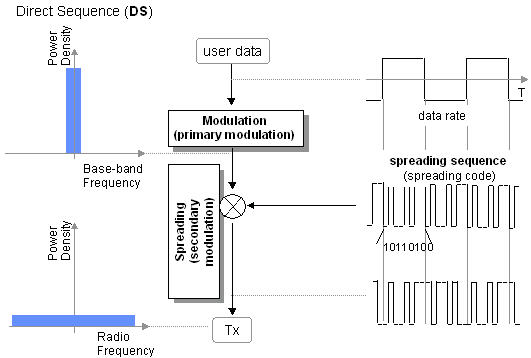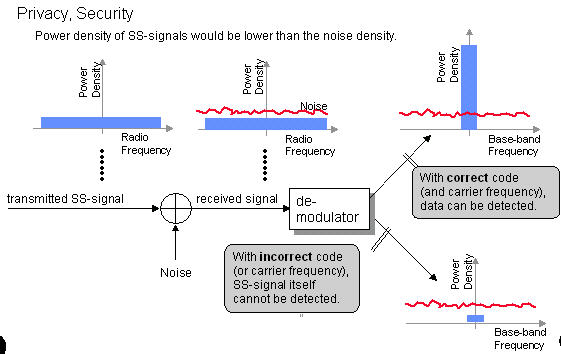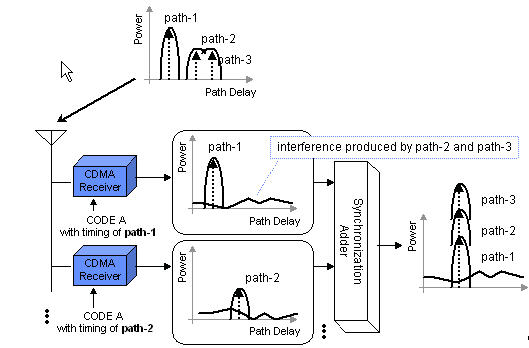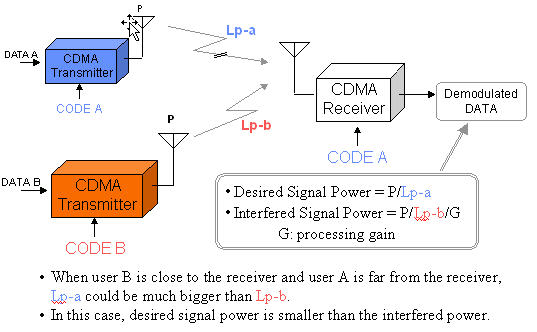Difference between revisions of "CDMA Basics"
(→Soft Handoff) |
(→Near Far Problem) |
||
| (9 intermediate revisions by 3 users not shown) | |||
| Line 27: | Line 27: | ||
==== Handoff ==== | ==== Handoff ==== | ||
| − | The final obstacle in the development of the cellular network involved the problem created when a mobile subscriber traveled from one cell to another during a call. As adjacent areas do not use the same radio channels, a call must either be dropped or transferred from one radio channel to another when a user crosses the line between adjacent cells. Because dropping the call is unacceptable, | + | The final obstacle in the development of the cellular network involved the problem created when a mobile subscriber traveled from one cell to another during a call. As adjacent areas do not use the same radio channels, a call must either be dropped or transferred from one radio channel to another when a user crosses the line between adjacent cells. Because dropping the call is unacceptable, theprocess of handoff was created. Handoff occurs when the mobile telephone network automatically transfers a call from radio channel to radio channel as a mobile crosses adjacent cells. |
==Evolution of Cellular Systems== | ==Evolution of Cellular Systems== | ||
| Line 39: | Line 39: | ||
In this system, each user is allocated a different time slot. Forward link frequency and reverse link frequency is the same. A synchronous switch is responsible for the time switching. | In this system, each user is allocated a different time slot. Forward link frequency and reverse link frequency is the same. A synchronous switch is responsible for the time switching. | ||
[[Image:cdma10.jpg|thumb|600px|center|TDMA]] | [[Image:cdma10.jpg|thumb|600px|center|TDMA]] | ||
| + | |||
| + | ===<span style="color:#C41E3A">Like this report?</span>=== | ||
| + | <p align="center"> '''This is only a sample report with brief analysis''' <br> | ||
| + | '''Dolcera can provide a comprehensive report customized to your needs'''</p> | ||
| + | {|border="2" cellspacing="0" cellpadding="4" align="center" " | ||
| + | |style="background:lightgrey" align = "center" colspan = "3"|'''[mailto:info@dolcera.com <span style="color:#0047AB">Buy the customized report from Dolcera</span>]''' | ||
| + | |- | ||
| + | | align = "center"| [http://www.dolcera.com/website_prod/services/ip-patent-analytics-services Patent Analytics Services] | ||
| + | |align = "center"| [http://www.dolcera.com/website_prod/services/business-research-services Market Research Services] | ||
| + | |align = "center"| [http://www.dolcera.com/website_prod/tools/patent-dashboard Purchase Patent Dashboard] | ||
| + | |- | ||
| + | |align = "center"| [http://www.dolcera.com/website_prod/services/ip-patent-analytics-services/patent-search/patent-landscapes Patent Landscape Services] | ||
| + | |align = "center"| [http://www.dolcera.com/website_prod/research-processes Dolcera Processes] | ||
| + | |align = "center"| [http://www.dolcera.com/website_prod/industries Industry Focus] | ||
| + | |- | ||
| + | |align = "center"| [http://www.dolcera.com/website_prod/services/ip-patent-analytics-services/patent-search/patent-landscapes Patent Search Services] | ||
| + | |align = "center"| [http://www.dolcera.com/website_prod/services/ip-patent-analytics-services/alerts-and-updates Patent Alerting Services] | ||
| + | |align = "center"| [http://www.dolcera.com/website_prod/tools Dolcera Tools] | ||
| + | |- | ||
| + | |} | ||
| + | <br> | ||
=== Code Division Multiple Access === | === Code Division Multiple Access === | ||
| Line 62: | Line 83: | ||
=== Frequency Reuse === | === Frequency Reuse === | ||
The number of radio channel frequencies is limited. The concept of frequency reuse is based on assigning to each cell a group of radio channels used within a small geographic area. Cells are assigned a group of channels that is completely different from neighboring cells. The coverage area of cells is called the footprint. This footprint is limited by a boundary so that the same group of channels can be used in different cells that are far enough away from each other so that their frequencies do not interfere. | The number of radio channel frequencies is limited. The concept of frequency reuse is based on assigning to each cell a group of radio channels used within a small geographic area. Cells are assigned a group of channels that is completely different from neighboring cells. The coverage area of cells is called the footprint. This footprint is limited by a boundary so that the same group of channels can be used in different cells that are far enough away from each other so that their frequencies do not interfere. | ||
| + | ... | ||
=== Soft Handoff === | === Soft Handoff === | ||
| Line 70: | Line 92: | ||
[[Image:cdma15.jpg|thumb|center|600px|RAKE receiver]] | [[Image:cdma15.jpg|thumb|center|600px|RAKE receiver]] | ||
=== Near Far Problem === | === Near Far Problem === | ||
| − | The problem is best described by taking an example: Consider a receiver and two transmitters (one close to the receiver; the other far away). If both transmitters transmit simultaneously and at equal powers, then due to the inverse square law (Since, '''Pr= Pt/ (4*Pi*d/lambda)^2''', '''Pr''' is received power, '''Pt''' is the transmitted power, '''d''' is the distance between the stations, '''lambda''' is the wavelength of operation and '''Pi''' is 3. | + | The problem is best described by taking an example: Consider a receiver and two transmitters (one close to the receiver; the other far away). If both transmitters transmit simultaneously and at equal powers, then due to the inverse square law (Since, '''Pr= Pt/ (4*Pi*d/lambda)^2''', '''Pr''' is received power, '''Pt''' is the transmitted power, '''d''' is the distance between the stations, '''lambda''' is the wavelength of operation and '''Pi''' is 3.14159265), the receiver will receive more power from the nearer transmitter. This makes the farther transmitter voice more difficult to understand. Since one transmission's signal is the other's noise the signal-to-noise ratio (SNR) for the farther transmitter is much lower. If the nearer transmitter transmits a signal that is orders of magnitude higher than the farther transmitter, then the SNR for the farther transmitter may be below detectability and the farther transmitter may just as well not transmit. This effectively jams the communication channel. In CDMA systems, this is commonly solved by dynamic output power adjustment of the transmitters. That is, the closer transmitters use less power so that the SNR for all transmitters at the receiver is roughly the same. This sometimes can have a noticeable impact on battery life, which can be dramatically different depending on distance from the base station. |
[[Image:cdma16.jpg|thumb|600px|center|Dynamic output power adjustment for CDMA transmitters]] | [[Image:cdma16.jpg|thumb|600px|center|Dynamic output power adjustment for CDMA transmitters]] | ||
| Line 81: | Line 103: | ||
'''Effect of Power Control''': Power control is capable of compensating the fading fluctuation. Received power from all MS are controlled to be equal. Near-Far problem is mitigated by the power control. | '''Effect of Power Control''': Power control is capable of compensating the fading fluctuation. Received power from all MS are controlled to be equal. Near-Far problem is mitigated by the power control. | ||
[[Image:cdma19.jpg]] | [[Image:cdma19.jpg]] | ||
| + | |||
| + | ==<span style="color:#C41E3A">Like this report?</span>== | ||
| + | <p align="center"> '''This is only a sample report with brief analysis''' <br> | ||
| + | '''Dolcera can provide a comprehensive report customized to your needs'''</p> | ||
| + | {|border="2" cellspacing="0" cellpadding="4" align="center" " | ||
| + | |style="background:lightgrey" align = "center" colspan = "3"|'''[mailto:info@dolcera.com <span style="color:#0047AB">Buy the customized report from Dolcera</span>]''' | ||
| + | |- | ||
| + | | align = "center"| [http://www.dolcera.com/website_prod/services/ip-patent-analytics-services Patent Analytics Services] | ||
| + | |align = "center"| [http://www.dolcera.com/website_prod/services/business-research-services Market Research Services] | ||
| + | |align = "center"| [http://www.dolcera.com/website_prod/tools/patent-dashboard Purchase Patent Dashboard] | ||
| + | |- | ||
| + | |align = "center"| [http://www.dolcera.com/website_prod/services/ip-patent-analytics-services/patent-search/patent-landscapes Patent Landscape Services] | ||
| + | |align = "center"| [http://www.dolcera.com/website_prod/research-processes Dolcera Processes] | ||
| + | |align = "center"| [http://www.dolcera.com/website_prod/industries Industry Focus] | ||
| + | |- | ||
| + | |align = "center"| [http://www.dolcera.com/website_prod/services/ip-patent-analytics-services/patent-search/patent-landscapes Patent Search Services] | ||
| + | |align = "center"| [http://www.dolcera.com/website_prod/services/ip-patent-analytics-services/alerts-and-updates Patent Alerting Services] | ||
| + | |align = "center"| [http://www.dolcera.com/website_prod/tools Dolcera Tools] | ||
| + | |- | ||
| + | |} | ||
| + | <br> | ||
| + | ==Contact Dolcera== | ||
| + | |||
| + | {| style="border:1px solid #AAA; background:#E9E9E9" align="center" | ||
| + | |- | ||
| + | ! style="background:lightgrey" | Samir Raiyani | ||
| + | |- | ||
| + | | '''Email''': [mailto:info@dolcera.com info@dolcera.com] | ||
| + | |- | ||
| + | | '''Phone''': +1-650-269-7952 | ||
| + | |} | ||
Latest revision as of 16:46, 10 March 2011
Contents
[hide]Cellular Communication
A cellular mobile communications system uses a large number of low-power wireless transmitters to create cells — the basic geographic service area of a wireless communications system. Variable power levels allow cells to be sized according to the subscriber density and demand within a particular region. As mobile users travel from cell to cell, their conversations are handed off between cells to maintain seamless service. Channels (frequencies) used in one cell can be reused in another cell some distance away. Cells can be added to accommodate growth, creating new cells in unserved areas or overlaying cells in existing areas. Source
There are three main entities in cellular communication
- Mobile Station (MS): A mobile station consists of 2 entities - equipment and SIM card
- Base Transceiver station(BTS): A base transceiver station consists of 2 entities - a base transceiver (transmitter and receiver) station and a base station controller. The BTS is the antenna tower site.
- Main Switching centre(MSC): The main switching centre is the heart of the network - the central switching office which controls all the base stations and provides connection with landline phones. It performs three main tasks. It:
- connects calls from sender to receiver,
- collects details of the calls made and received, and
- supervises operation of the rest of the network components.
Cellular System Architecture
Cellular systems are increasing in demand as more users are added to their systems. The amount of frequency spectrum available for mobile cellular use was limited, and efficient use of the required frequencies was needed for mobile cellular coverage. In modern cellular telephony, rural and urban regions are divided into areas according to specific provisioning guidelines. Provisioning for each region is planned according to an engineering plan that includes cells, clusters, frequency reuse, and handovers.
Cells
A cell is the basic geographic unit of a cellular system. Cells are base stations transmitting over small geographic areas that are represented as hexagons.
Clusters
A cluster is a group of cells. No channels are reused within a cluster. Normally a cluster has seven cells in it as shown below.
Frequency Reuse
The number of radio channel frequencies is limited. The concept of frequency reuse is based on assigning to each cell a group of radio channels used within a small geographic area. Cells are assigned a group of channels that is completely different from neighboring cells. The coverage area of cells is called the footprint. This footprint is limited by a boundary so that the same group of channels can be used in different cells that are far enough away from each other so that their frequencies do not interfere.
Cell Splitting
As a service area becomes full of users, this approach is used to split a single area into smaller ones. In this way, urban centers can be split into as many areas as necessary to provide acceptable service levels in heavy-traffic regions, while larger, less expensive cells can be used to cover remote rural regions.
Handoff
The final obstacle in the development of the cellular network involved the problem created when a mobile subscriber traveled from one cell to another during a call. As adjacent areas do not use the same radio channels, a call must either be dropped or transferred from one radio channel to another when a user crosses the line between adjacent cells. Because dropping the call is unacceptable, theprocess of handoff was created. Handoff occurs when the mobile telephone network automatically transfers a call from radio channel to radio channel as a mobile crosses adjacent cells.
Evolution of Cellular Systems
Multiple Access Methods
There are predominantly three types of multiple access methods.
Frequency Division Multiple Access
In this system, each user is allotted a different set of frequencies to operate upon. The uplink(mobile to base station) frequency is different from downlink frequency(base station to mobile).
Time Division Multiple Access
In this system, each user is allocated a different time slot. Forward link frequency and reverse link frequency is the same. A synchronous switch is responsible for the time switching.
Like this report?
This is only a sample report with brief analysis
Dolcera can provide a comprehensive report customized to your needs
Code Division Multiple Access
There is no restriction on time and frequency in this scheme. All the users can transmit at all times and at all frequencies. Because users are isolated by code, they can share the same carrier frequency, eliminating the frequency reuse problem encountered in other technologies.
A comparative study between the above three access technologies with respect to time and frequency is as shown below.
Code Division Multiple Access
The CDMA technology can be implemented by spreading the spectrum which can be done in the following two ways
- Direct Sequence Spread Sprectrum - DSSS CDMA
- Frequency Hopping - FH CDMA
Direct Sequence Spread Sprectrum - DSSS CDMA
In this method, the direct sequence(input data) which is spread over a limited bandwidth is multiplied with a code or spreading sequence (a pseudorandom sequence also known as PN sequence) which will spread the input data over the entire bandwidth of the communication channel. The power density is also reduced and is spread over the frequency spectrum and hence is known as spread spectrum method. The modulation part of DSSS is as shown below.
The modulated signal is transmitted over the channel and all users can receive it but only the user which knows the correct code can decode the message. This is depicted in the figure below.
- CDMA's spread spectrum technique overlaps every transmission on the same carrier frequency by assigning a unique code to each conversation.
- The signal is spread at two levels first using a Walsh Code and then using a PN Code. The number of bits in either of the two codes is known as the "chip rate," and each bit in the spreading signal is called a "chip". One bit from each conversation (baseband signal)is multiplied with the walsh code and then the PN code by the spreading techniques, giving the receiving side an enormous amount of data it can average just to determine the value of one bit.
- Base station is the one that assigns spreading code to each call when a mobile requests for a call (unique Walsh code for each conversation and a same PN code for each call in a cell sector). In the analysis henceforth we discuss the dynamic allocation of these spread codes in accordance with the required QoS.
Frequency Reuse
The number of radio channel frequencies is limited. The concept of frequency reuse is based on assigning to each cell a group of radio channels used within a small geographic area. Cells are assigned a group of channels that is completely different from neighboring cells. The coverage area of cells is called the footprint. This footprint is limited by a boundary so that the same group of channels can be used in different cells that are far enough away from each other so that their frequencies do not interfere. ...
Soft Handoff
Handoff means switching a cellular phone transmission from one cell to another as a mobile user moves into a new cellular area. It is so called because the radio link with the previous sector(s) is not broken before a link is established with a new sector; this type of handoff is described as "make before break". In CDMA, due to this soft handoff, there is no interruption of call even at the border of a cell site which means more number of customers can be accommodated, automatically increasing the capacity of the cell site.This is make-before-break technology.
Multipath Fading
In a mobile environment, a mobile station will receive one direct signal from the base station and multiple signals which are reflected from obstructions like buildings and towers. Each signal would have travelled a different length and would be displaced in time. Due to this, when they are combined at the mobile handset, it will cause interference resulting in poor signal quality. This is known as fading. This problem is handled in a very good way in CDMA. Here, the phase of the multiple signals is modified such that only positive interference(addition) takes place and the overall signal strength increases. A receiver that implements the above principle is known as a RAKE receiver as shown in the figure below.
Near Far Problem
The problem is best described by taking an example: Consider a receiver and two transmitters (one close to the receiver; the other far away). If both transmitters transmit simultaneously and at equal powers, then due to the inverse square law (Since, Pr= Pt/ (4*Pi*d/lambda)^2, Pr is received power, Pt is the transmitted power, d is the distance between the stations, lambda is the wavelength of operation and Pi is 3.14159265), the receiver will receive more power from the nearer transmitter. This makes the farther transmitter voice more difficult to understand. Since one transmission's signal is the other's noise the signal-to-noise ratio (SNR) for the farther transmitter is much lower. If the nearer transmitter transmits a signal that is orders of magnitude higher than the farther transmitter, then the SNR for the farther transmitter may be below detectability and the farther transmitter may just as well not transmit. This effectively jams the communication channel. In CDMA systems, this is commonly solved by dynamic output power adjustment of the transmitters. That is, the closer transmitters use less power so that the SNR for all transmitters at the receiver is roughly the same. This sometimes can have a noticeable impact on battery life, which can be dramatically different depending on distance from the base station.
Power Control
As the propagation losses between BS and MS's are different according to individual communication distances, the received levels at the base station are different from each other when all mobile stations transmit their signals at the same power. Moreover, the received level fluctuates quickly due to fading. In order to maintain the strength of received signal level at BS, power control technique must be employed in CDMA systems.
.

Power control can be implemented in two ways : open loop power control and closed loop power control
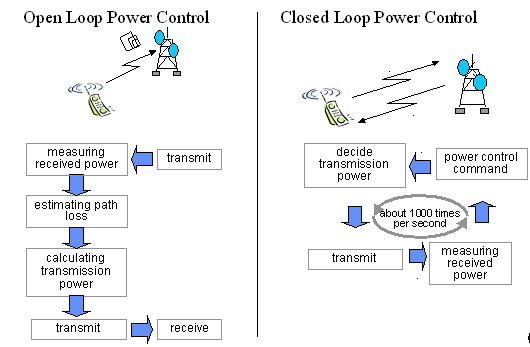
Effect of Power Control: Power control is capable of compensating the fading fluctuation. Received power from all MS are controlled to be equal. Near-Far problem is mitigated by the power control.

Like this report?
This is only a sample report with brief analysis
Dolcera can provide a comprehensive report customized to your needs
Contact Dolcera
| Samir Raiyani |
|---|
| Email: info@dolcera.com |
| Phone: +1-650-269-7952 |
